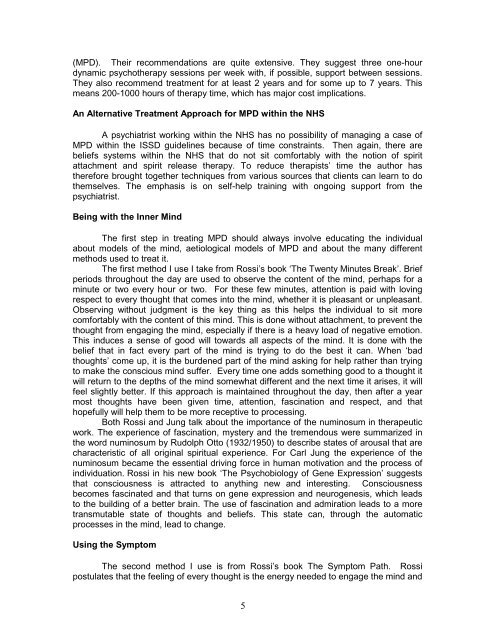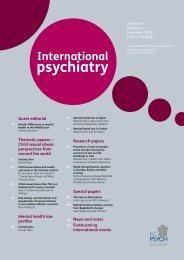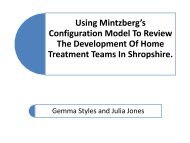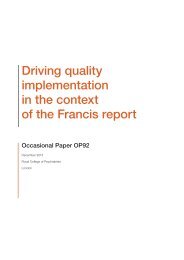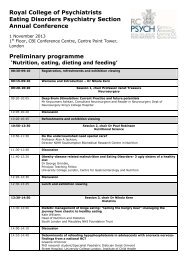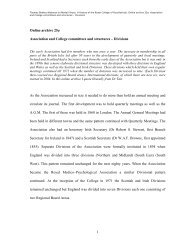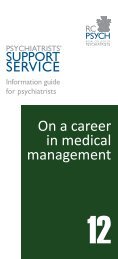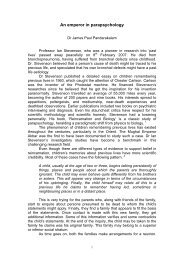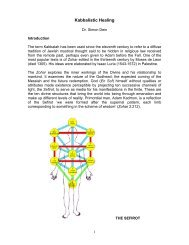'Multiple Personality Disorder - Demons and Angels or Archetypal ...
'Multiple Personality Disorder - Demons and Angels or Archetypal ...
'Multiple Personality Disorder - Demons and Angels or Archetypal ...
Create successful ePaper yourself
Turn your PDF publications into a flip-book with our unique Google optimized e-Paper software.
(MPD). Their recommendations are quite extensive. They suggest three one-hour<br />
dynamic psychotherapy sessions per week with, if possible, supp<strong>or</strong>t between sessions.<br />
They also recommend treatment f<strong>or</strong> at least 2 years <strong>and</strong> f<strong>or</strong> some up to 7 years. This<br />
means 200-1000 hours of therapy time, which has maj<strong>or</strong> cost implications.<br />
An Alternative Treatment Approach f<strong>or</strong> MPD within the NHS<br />
A psychiatrist w<strong>or</strong>king within the NHS has no possibility of managing a case of<br />
MPD within the ISSD guidelines because of time constraints. Then again, there are<br />
beliefs systems within the NHS that do not sit comf<strong>or</strong>tably with the notion of spirit<br />
attachment <strong>and</strong> spirit release therapy. To reduce therapists’ time the auth<strong>or</strong> has<br />
theref<strong>or</strong>e brought together techniques from various sources that clients can learn to do<br />
themselves. The emphasis is on self-help training with ongoing supp<strong>or</strong>t from the<br />
psychiatrist.<br />
Being with the Inner Mind<br />
The first step in treating MPD should always involve educating the individual<br />
about models of the mind, aetiological models of MPD <strong>and</strong> about the many different<br />
methods used to treat it.<br />
The first method I use I take from Rossi’s book ‘The Twenty Minutes Break’. Brief<br />
periods throughout the day are used to observe the content of the mind, perhaps f<strong>or</strong> a<br />
minute <strong>or</strong> two every hour <strong>or</strong> two. F<strong>or</strong> these few minutes, attention is paid with loving<br />
respect to every thought that comes into the mind, whether it is pleasant <strong>or</strong> unpleasant.<br />
Observing without judgment is the key thing as this helps the individual to sit m<strong>or</strong>e<br />
comf<strong>or</strong>tably with the content of this mind. This is done without attachment, to prevent the<br />
thought from engaging the mind, especially if there is a heavy load of negative emotion.<br />
This induces a sense of good will towards all aspects of the mind. It is done with the<br />
belief that in fact every part of the mind is trying to do the best it can. When ‘bad<br />
thoughts’ come up, it is the burdened part of the mind asking f<strong>or</strong> help rather than trying<br />
to make the conscious mind suffer. Every time one adds something good to a thought it<br />
will return to the depths of the mind somewhat different <strong>and</strong> the next time it arises, it will<br />
feel slightly better. If this approach is maintained throughout the day, then after a year<br />
most thoughts have been given time, attention, fascination <strong>and</strong> respect, <strong>and</strong> that<br />
hopefully will help them to be m<strong>or</strong>e receptive to processing.<br />
Both Rossi <strong>and</strong> Jung talk about the imp<strong>or</strong>tance of the numinosum in therapeutic<br />
w<strong>or</strong>k. The experience of fascination, mystery <strong>and</strong> the tremendous were summarized in<br />
the w<strong>or</strong>d numinosum by Rudolph Otto (1932/1950) to describe states of arousal that are<br />
characteristic of all <strong>or</strong>iginal spiritual experience. F<strong>or</strong> Carl Jung the experience of the<br />
numinosum became the essential driving f<strong>or</strong>ce in human motivation <strong>and</strong> the process of<br />
individuation. Rossi in his new book ‘The Psychobiology of Gene Expression’ suggests<br />
that consciousness is attracted to anything new <strong>and</strong> interesting. Consciousness<br />
becomes fascinated <strong>and</strong> that turns on gene expression <strong>and</strong> neurogenesis, which leads<br />
to the building of a better brain. The use of fascination <strong>and</strong> admiration leads to a m<strong>or</strong>e<br />
transmutable state of thoughts <strong>and</strong> beliefs. This state can, through the automatic<br />
processes in the mind, lead to change.<br />
Using the Symptom<br />
The second method I use is from Rossi’s book The Symptom Path. Rossi<br />
postulates that the feeling of every thought is the energy needed to engage the mind <strong>and</strong><br />
5


